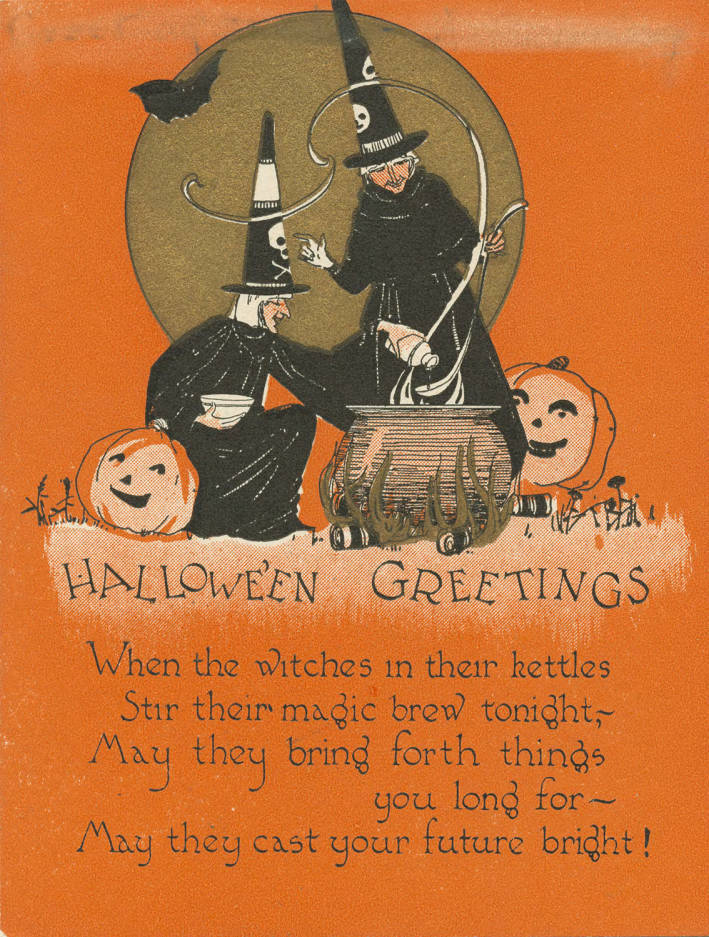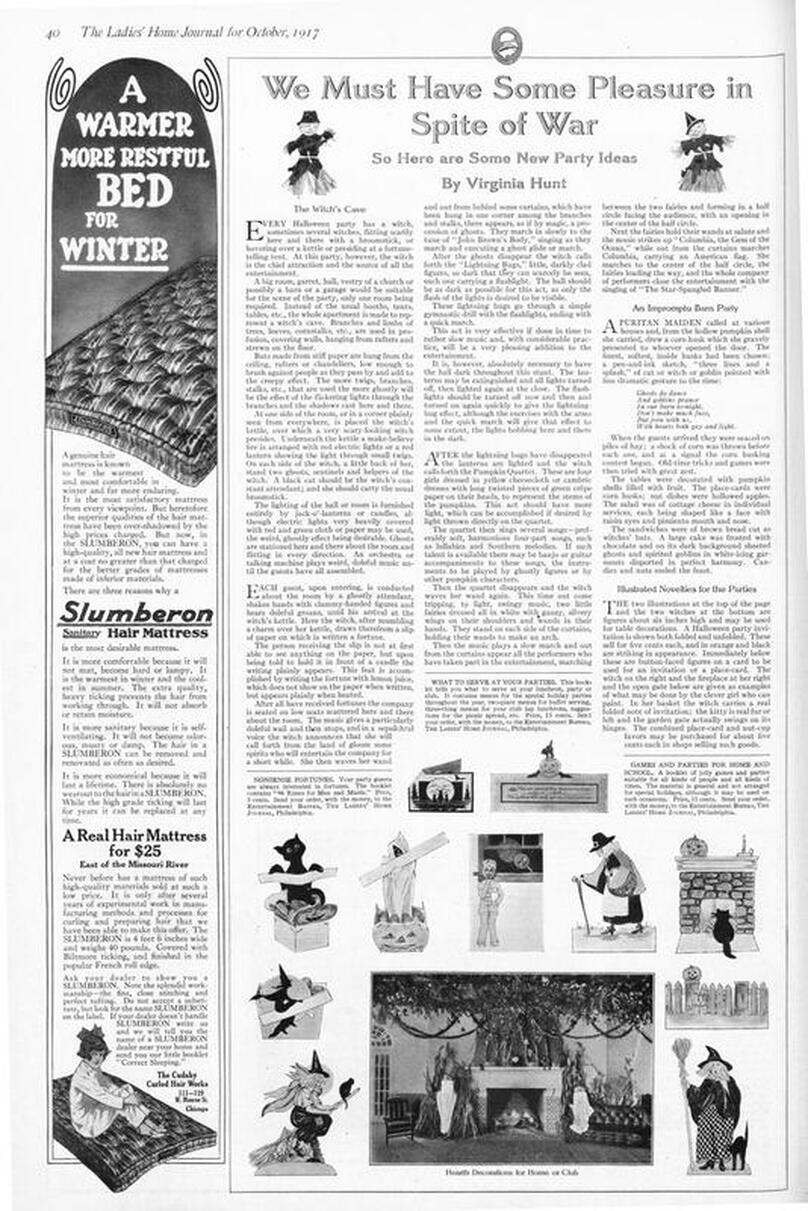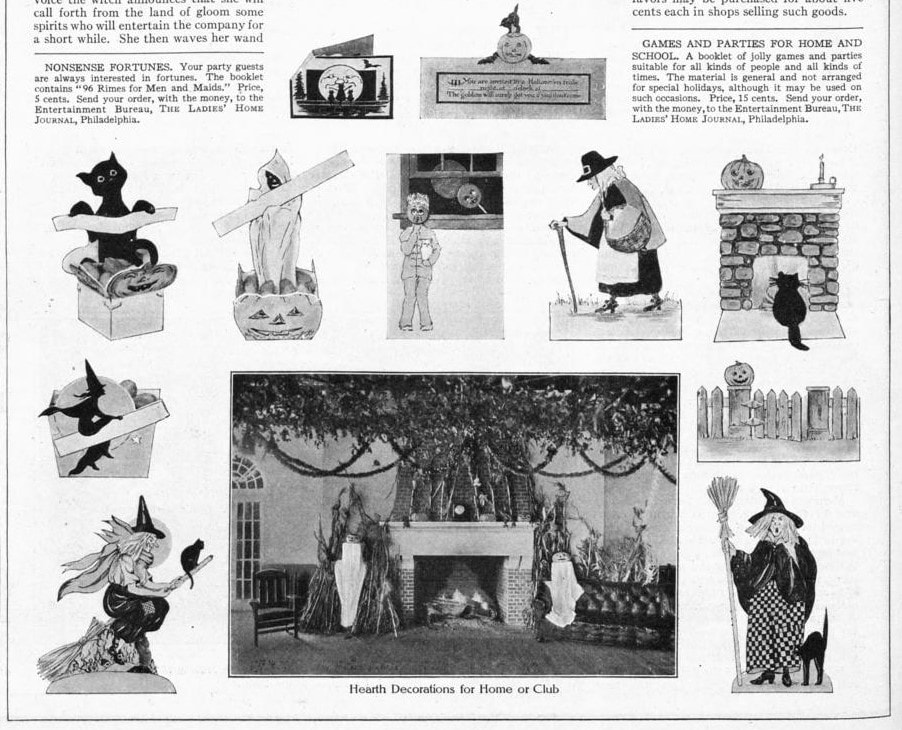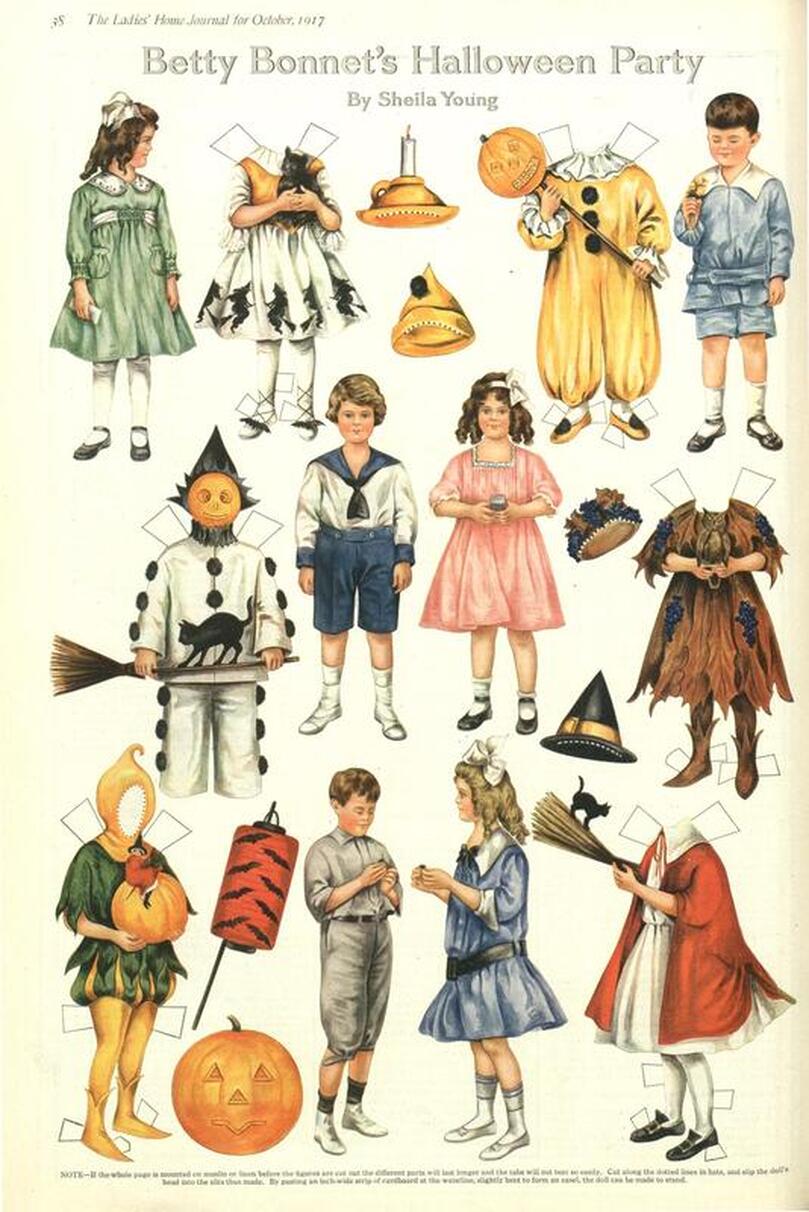|
Welcome to The Food Historian's 31 Days of Halloween extravaganza. Between social media (Facebook, Instagram, Twitter) and this blog, I'll be sharing vintage Halloween content nearly every day this month! References to Halloween during the First World War were few and far between but this little article caught my eye. Featured in the October, 1917 edition of the Ladies Home Journal, "We Must Have Some Pleasure in Spite of the War" by Virginia Hunt doesn't have much in the way of menu suggestions and recipes, but it does illustrate the typical ideas around Halloween parties at the time. A mixture of an excuse for teenaged romance, a little spookiness, and of course, the home economist's dream of a color-coordinated, crafty, event, sometimes with coordinated gymnastics. For fun, I've transcribed the original article verbatim below. Would you host a Halloween party with any of this advice?  Orange postcard featuring two witches adding ingredients to a cauldron - two smiling jack-o'-lanterns look on. Below reads, "Halloween Greetings - When the witches in their kettles Stir their magic brew tonight,-- May they bring forth things you long for -- May they cast your future bright!" Postcard c. 1920, Enoch Pratt Collection, Maryland Digital Collections. The Witch's Cave Every Halloween party has a witch, sometimes several witches, flitting scarily here and there with abroomstick, or hovering over a kettle or presiding at a fortune-telling tent. At this part, however, the witch is the chief attraction and the source of all the entertainment. A big room, garret, hall, vestry of a church or possibly a barn or a garage would be suitable for the scene of the party, only one room being required. Instead of the usual booths, tents, tables, etc., the whole apartment is made to represent a witch's cave. Branches and limbs of trees, leaves, cornstalks, etc., are used in profusion, covering walls, hanging from rafters and strewn on the floor. Bats made from stiff paper are hung from the ceiling, rafters or chandeliers, low enough to brush against people as they pass by and add to the creepy effect. The more twigs, branches, stalks, etc., that are used the more ghostly will be the effect of the flickering lights through the branches and the shadows cast here and there. At one side of the room, or in a corner plainly seen from everywhere, is placed the witch's kettle, over which a very scary-looking witch presides. Underneath the kettle a make-believe fire is arranged with red electric lights or a red lantern showing the light through small twigs. On each side of the witch, a little back of her, stand two ghosts, sentinels and helpers of the witch. A black cat should be the witch's constant attendant; and she should carry the usual broomstick. The lighting of the hall or room is furnished entirely by jack-o'-lanterns or candles, although electric lights very heavily covered with red and green cloth or paper may be used, the weird ghostly effect being desirable. Ghosts are stationed here and there about the room and flitting in every direction. An orchestra or talking machine plays weird, doleful music until the guests have all assembled. Each guest, upon entering, is conducted about the room by a ghostly attendant, shakes hands with clammy-handed figures and hears doleful groans, until his arrival at the witch's kettle. Here the witch, after mumbling a charm over her kettle, draws therefrom a slip of paper on which is written a fortune. The person receiving the slip is not at first able to see anything on the paper, but upon being told to hold it in front of a candle the writing plainly appears. This feat is accomplished by writing the fortune with lemon juice, which does not show on the paper when written, but appears plainly when heated. After all have received fortunes the company is seated on low seats scattered here and there about the room. The music gives a particularly doleful wail and then stops, and in a sepulchral voice the witch announces that she will call forth from the land of gloom some spirits who will entertain the company for a short while. She then waves her wand and out from behind some curtains, which have been hung in one corner among the branches and stalks, there appears, as ifby magic, a procession of ghosts. They march in slowly to the tune of "John Brown's Body," singing as they march and executing a ghost slide or march. After the ghosts disappear the witch calls forth the "Lightning Bugs," little, darkly clad figures, so dark that they can scarcely be seen, each one carrying a flashlight. The hall should be as dark as possible for this act, as only the flash of the lights is desired to be visible. These lightning bugs go through a simple gymnastic drill with the flashlights, ending with a quick march. This act is very effective if done in time to rather slow music and, with considerable practice, will be a very pleasing addition to the entertainment. It is, however, absolutely necessary to have the hall dark throughout this stunt. The lanterns may be extinguished and all lights turned off, then lighted again at the close. The flashlights should be turned off now and then and turned on again quickly to give the lightning-but effect, although the exercises with the arms and the quick march will give that effect to some extent, the lights bobbing here and there in the dark. After the lightning buts have disappeared the lanterns are lighted and the witch calls forth the Pumpkin Quartet. These are four girls dressed in yellow cheesecloth or cambric dresses with long twisted pieces of green crepe paper on their heads, to represent the stems of the pumpkins. This act should have more light, which can be accomplished if desired by light thrown directly on the quartet. The quartet then sings several songs - preferably soft, harmonious four-part songs, such as lullabies and Southern melodies. If such talent is available there may be banjo or guitar accompaniments to these songs, the instruments to be played by ghostly figures or by other pumpkin characters. Then the quartet disappears and the witch waves her wand again. This time out come tripping, to light, swingy music, two little fairies dressed all in white with gauzy, silvery wings on their shoulders and wands in their hands. They stand on each side of the curtains, holding their wands to make an arch. Then the music plays a slow march and out from the curtains appear all the performers who have taken part in the entertainment, marching between the two fairies and forming in a half circle facing the audience, with an opening in the center of the half circle. Next the fairies hold their wands at salute and the music strikes up "Columbia, the Gem of the Ocean," while out from the curtains marches Columbia, carrying an American flag. She marches to the center of the half circle, the fairies leading the way, and the whole company of performers close the entertainment with the singing of "The Star-Spangled Banner." An Impromptu Barn Party A Puritan maiden called at various houses and, from a hollow pumpkin shell she carried, drew a corn husk which she gravely presented to whoever opened the door. The finest, softest, inside husks had been chosen; a pen-and-ink sketch, "three lines and a splash," of cat or witch or goblin pointed with fine dramatic gesture to the rime: Ghosts do dance And goblins prance In our barn to-night. Don't make much fuss, But join with us, With hearts both gay and light. When the guests arrived they were seated on piles of hay; a shock of corn was thrown before each one, and at a signal the corn husking contest began. Old-time tricks and games were then tried with great zest. The tables were decorated with pumpkin shells filled with fruit. The place-cards were corn husks; nut dishes were hollowed apples. The salad was of cottage cheese in individual services, each being shaped like a face with raisin eyes and pimiento mouth and nose. The sandwiches were of brown bread cut as witches' hats. A large cake was frosted with chocolate and on its dark background sheeted ghosts and spirited goblins in white-icing garments disported in perfect harmony. Candies and nuts ended the feast. Illustrated Novelties for the Parties The two illustrations at the top of the page and the two witches at the bottom are figures about six inches high and may be used for table decorations. A Halloween part invitation is shown both folded and unfolded. These sell for five cents each, and in orange and black are striking in appearance. Immediately below these are button-faced figures on a card to be used for an invitation or a place-card. The witch on the right and the fireplace at her right and the open gate below are given as examples of what may be done by the clever girl who can paint. In her basket the witch carries a real folded note of invitation; the kitty is real fur or felt and the garden gate actually swings on its hinges. The combined place-card and nut-cup favors may be purchased for about five cents each in shops selling such goods. Well! The Witch's Party certainly seems like it would be a LOT of work to organize and put on, requiring quite a few actors. The patriotic ending featuring Columbia, while seemingly out of place among a Halloween production, was typical of the period and boosterism for the war effort. That being said, the adorable barn party seems much more doable, provided one can find corn for husking! What do you think? Would you add any of these ideas to YOUR Halloween party? And here's a little bonus - a fun page of paper dolls from that same issue of the Ladies' Home Journal! Which costume would you wear? The Food Historian blog is supported by patrons on Patreon! Patrons help keep blog posts like this one free and available to the public. Join us for awesome members-only content like free digitized cookbooks from my personal collection, e-newsletter, and even snail mail from time to time! Don't like Patreon? Leave a tip!
0 Comments
Your comment will be posted after it is approved.
Leave a Reply. |
AuthorSarah Wassberg Johnson has an MA in Public History from the University at Albany and studies early 20th century food history. Archives
July 2024
Categories
All
|




 RSS Feed
RSS Feed